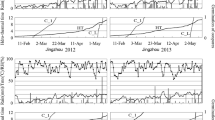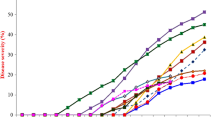Abstract
Stem canker (SC), caused by Diaporthe helianthi, is the most serious sunflower disease in Uruguay. Yield losses have been estimated up to 75%. Chemical control is one of the strategies used to manage this disease, but fungicide application should be done before symptoms are visible. Ascospores are the primary source of inoculum, they are produced in perithecia which develop in infected stubble and are dispersed by wind to infect plants. As in other monocyclic diseases, quantifying primary inoculum is essential to predict an epidemic. In this study, ascospores were trapped on microscope slides with solid petroleum jelly which were placed on top of flat open cages filled with natural infected stubble. Cages were placed outdoors, slides where replaced twice a week and stained ascospores were counted under the microscope. Our objective was to develop weather-based models to predict ascospore release levels of D. helianthi from infected stubble. Explanatory weather variables were calculated during the seven-day periods prior to each field weekly ascospore count using daily weather station data from La Estanzuela, Uruguay. Then, logistic models were fit to estimate probabilities of having severe or moderate to light levels of ascospore counts. The best models included variables associated to the precipitation and dew-induced wetness frequency, combinated with the simultaneous occurrence of high relative humidity or low thermal amplitude records. Estimating the evolution of ascospore release through the weather-based models might help to guide preventive fungicide applications to control stem canker in Uruguay.




Similar content being viewed by others
References
Battilani P, Rossi V, Girometta B, Delos M, Rouzet J, André N, Esposito S (2003) Estimating the potential development of Diaporthe helianthi epidemics in Italy. Bulletin OEPP/EPPO Bulletin 33:427–431
De Wolf ED, Madden LV, Lipps PE (2003) Risk assessment models for wheat fusarium head blight epidemics based in within-season weather data. Phytopathology 93:428–435
Delos M, Moinard J (1996) ASPHODEL: modele de simulation des épidémies de Phomopsis du tournesol (Diaporthe helianthi). Med Fac Landbouww Univ Gent 61(2b):555–565
Delos M, Moinard J, Jacquin D (1995) Etude et surveillance du Phomopsis, des pieges au modele. Phytoma 473:25–27
Dummel DM, Agostini JP, Moschini R (2015) Predictive model for ascospore release of Guignardia citricarpa using climatological data. Acta Hortic 1065:953–963. https://doi.org/10.17660/ActaHortic.2015.1065.119
Fálico de Alcaraz L, Visintín G, Alcaraz Fálico ME (1994) El cancro del tallo del girasol Diaporthe helianthi Munt. Cvet In: Ciencia, Docencia y Tecnología 8:19–26
Fálico L, Alcaraz Fálico ME, Visintín G, García B (2003) Relación entre las condiciones climáticas, aparición de síntomas e incidencia del cancro del tallo del girasol (Diaporthe helianthi). Ciencia, Docencia y Tecnología 27:167–177
Harveson RM, Markell SG, Block CC, Gulpa TJ (2016) Compendium of sunflower diseases and pests. APS press, St Paul, Minnesota, U.S.A.
Hawksworth DL, Kirk PM, Sutton BC, Pegler DN (1995) Ainsworth & Bisby’s dictionary of fungi. 8th edition. International Mycological Institute, CAB International. University Press, Cambridge, UK
Herr LJ, Lipps PE, Watters BL (1983) Diaporthe stem canker of sunflower. Plant Dis 67:911–913
Kendrick B (2000) The fifth kingdom. 3rd edition. Focus publishing, R. Pullins Co., Newburyport, MA, USA
Laville J (1986) Cahier technique tournesol: maladie. Cetiom, Paris
Le page R (1994) Le Phomopsis du tournesol. Numero special Oleoscope, Cetiom N 14, vol 67
Madden LV, Hughes G, van den Bosch F. (2007) The study of plant disease epidemics. The American Phytopathological society. St. Paul, Mn, USA. 421 pp.
Masirevic S, Gulya TJ (1992) Sclerotinia and Phomopsis—two devastating sunflower pathogens. Field Crops Res 30:271–300
Mathew FM, Alananbeh MK, Jordahl JG, Meyer SM, Castlebury LA, Gulya TJ, Markell SG (2015) Phomopsis stem canker: a reemerging threat to sunflower (Helianthus annuus) in the United States. Phytopathology 105:990–997
Moschini RC, Canteros BI, Martínez MI, De Ruyver R (2014) Quantification of the environmental effect on citrus canker intensity at increasing distances from a natural windbreak in northeastern Argentina. Australas Plant Pathol 43:653–662
Muntañola-Cvetkovic M, Mihaljcevic M, Petrov M (1981) On the identity of the causative agent of a serious Phomopsis-Diaporthe disease in sunflower plants. Nova Hedwigia 34:417–435
Olson TR, Kontz B, Markell SG, Gulya TJ, Mathew FM (2017) First report of Diaporthe stewartii causing phomopsis stem canker of sunflower (Helianthus annuus) in Minnesota. Plant Dis 101:382–382
Sancho AM, Moschini RC, Filippini S, Rojas D, Ricca A (2018) Weather-based logistic models to estimate total fumonisin levels in maize kernels at export terminals in Argentina. Tropical Plant Pathology 43:99–108
Stewart S, Rodríguez M (2018) Cancro del tallo: epidemiología y control en Uruguay. 1° Taller de Enfermedades de Cultivos Extensivos, Escuela de Ciencias Agrarias Naturales y Ambientales de la UNNOBA. Pergamino, Argentina
Thompson SM, Tan YP, Young AJ, Neate SM, Aitken EAB, Shivas RG (2011) Stem cankers on sunflower (Helianthus annuus) in Australia reveal a complex of pathogenic Diaporthe (Phomopsis) species. Persoonia 27:80–89
Author information
Authors and Affiliations
Corresponding author
Ethics declarations
Conflict of interest
All authors of the manuscript submitted to Australasian Plant Pathology, point out that we have no potential conflict of interest.
Rights and permissions
About this article
Cite this article
Moschini, R.C., Rodríguez, M.J., Martínez, M.I. et al. Weather-based predictive models for Diaporthe helianthi ascospore release in Uruguay. Australasian Plant Pathol. 48, 519–527 (2019). https://doi.org/10.1007/s13313-019-00655-x
Received:
Accepted:
Published:
Issue Date:
DOI: https://doi.org/10.1007/s13313-019-00655-x




